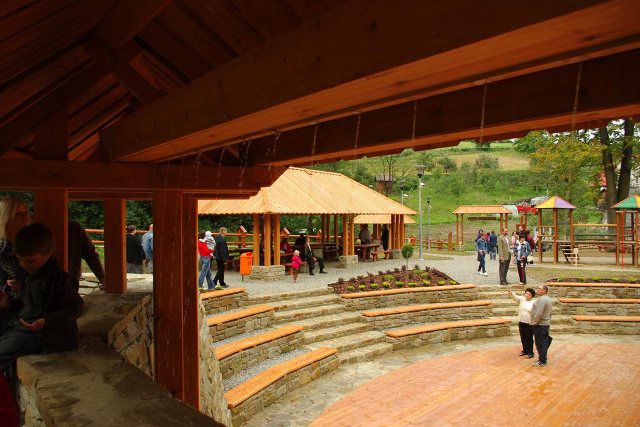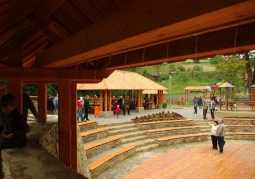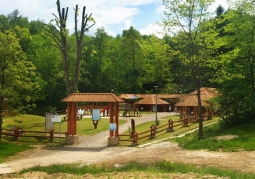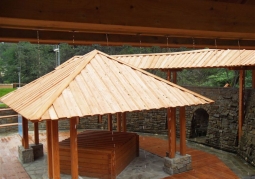Brine graduation tower - Sołonka
No weather data
0.0 /5
Number of ratings: 0
The source of salt water in Sołonka is a remnant of the Miocene period, when the Podkarpackie region was covered with a warm sea (about 23 million - 5 million years ago). They are part of the so-called Podkarpackie brines occurring along the Carpathian Foothills in the Sanok-Przemyśl brine belt in the western part of the Ruthenian region. They were exploited for sure in the 16th and 17th centuries when salt was brewed on a large rock. At that time, the salt well located here was created. It comes from 1596 (dendrochronological research of AGH Kraków), 26 meters deep, timbered with pine wood, the so-called technique. at the cutting edge. The mining equipment together with the intake roller and numerous fragments of the wooden casing of the well survived in very good condition. They can be viewed at the Regional Museum in Sołonka. These are the only objects of this type preserved in Podkarpacie. At the turn of the 16th and 17th centuries, Sołonka was in the hands of the Ligęz family from Rzeszów. The brewed salt in Sołonka was then sold on the market in Rzeszów, where the Ligęzów created salt tables for this purpose. It is not known when or why industrial sources were abandoned. The well was already filled up in the 17th century, with time forgotten and almost completely overgrown and covered with a thick layer of soil and stone. From the mid-seventeenth century until the end of World War II, brine was derived from the natural depression of the area and used only by local people for their own needs. In 1999, on the basis of an indication of a resident of Sołonka and the owner of this plot, Zofia Babiarz, the spring was found again. Two years later, i.e. in 2001, after the ownership of the plot by the Commune of Lubenia, the cembrovine was excavated and cleaned to a depth of 26 m and cleaning work was carried out around it. During the works, it was noticed that the brine did not flow from the bottom of the well but from the side wall and flow down, filling the timber. Further deepening was not justified because the bottom of the well was lined with boards, which suggested that the timbered wood served as a brine tank. In the years 2009-2010, a spa salt cascade was created here, as iodine found in brines has health properties. The construction of the cascade was financed from the resources of the Lubenia Commune and the European Union under the Rural Development Program for 2007-2013. Currently, iodine-rich brine has become one of the region's tourist and recreational attractions. The Kaskada Brine area is available every day around the clock, while the graduation tower pumps and fountain operate from 10:00 to 21:00. Free admission.
Komentarze
No results
Nearby places
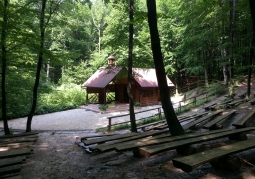
Studzianka spring in Przylasek - Hermanowa
Category: Lakes, springs, waterfallsThe spring in Przylaskie is a quiet place located just outside the city of Rzeszów, allowing you a moment of rest and relaxation. It is a frequent destination for bicycle and car trips for the inhabitants of Rzeszów...
7 km
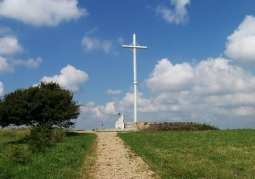
Millennium Cross and observation platform - Niechobrz
Category: LookoutsIt is an ideal place for lovers of beautiful and distant views. The Millennium Cross with the observation platform located at its foot is located on a hill in Niechobrz Górny, thanks to which it allows us to observe...
13 km
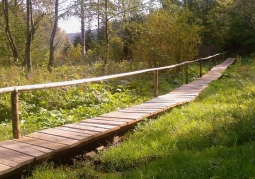
Mójka Nature Reserve - Futoma
Category: Nature reservesA nature reserve located in the Błażowa commune, covering the areas of Futoma and Kąkolówka. The subject of protection of the area is beech and fir forest and settled in water and mud communities of beavers. Wooden...
14 km
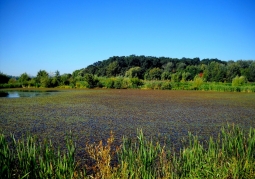
Lisia Góra Nature Reserve - Rzeszów
Category: Nature reservesThe reserve has an area of about 8 ha. Lisia Góra is the seventh stop of the Nature Trail Władysława Szafera - other stops are: Old Cemetery - Olszynki - Culture and Recreation Park - Dam - Below the Electronic...
14 km
Nearby places

Studzianka spring in Przylasek - Hermanowa
Category: Lakes, springs, waterfallsThe spring in Przylaskie is a quiet place located just outside the city of Rzeszów, allowing you a moment of rest and relaxation. It is a frequent destination for bicycle and car trips for the inhabitants of Rzeszów...
7 km

Millennium Cross and observation platform - Niechobrz
Category: LookoutsIt is an ideal place for lovers of beautiful and distant views. The Millennium Cross with the observation platform located at its foot is located on a hill in Niechobrz Górny, thanks to which it allows us to observe...
13 km

Mójka Nature Reserve - Futoma
Category: Nature reservesA nature reserve located in the Błażowa commune, covering the areas of Futoma and Kąkolówka. The subject of protection of the area is beech and fir forest and settled in water and mud communities of beavers. Wooden...
14 km

Lisia Góra Nature Reserve - Rzeszów
Category: Nature reservesThe reserve has an area of about 8 ha. Lisia Góra is the seventh stop of the Nature Trail Władysława Szafera - other stops are: Old Cemetery - Olszynki - Culture and Recreation Park - Dam - Below the Electronic...
14 km
